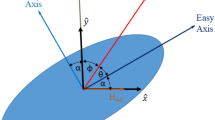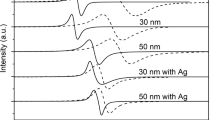Abstract
THE molecular field postulated by Weiss to explain ferromagnetism is regarded by Becker1 as mechanical in origin, representing the control exerted by strain within any portion of a crystal upon the direction in which that portion may retain its magnetisation in the absence of externally applied magnetic fields. More recently, Becker and Kirsten2 have discussed some interesting experiments upon the magnetisation of nickel under tension. They arrive at the conclusion that, at least for applied fields much larger than the coercive force—which becomes as small as one or two gauss under their extreme conditions—the magnetisation may be predicted quantitatively from the maximal magnetostrictive shortening of well annealed metal and the saturation intensity of magnetisation, both of which quantities are sufficiently well known from previous experiments by others. Their account of the effect of internal stresses over the cross-section of a wire specimen upon its magnetisation is also very satisfactory. They point out, in the second footnote to p. 660, that the “extremely irreversible processes” observed in weak applied fields are not correctly represented by Becker's theory, magnetic changes being observed at field values which are less than the theory predicts as necessary for their occurrence.*
This is a preview of subscription content, access via your institution
Access options
Subscribe to this journal
Receive 51 print issues and online access
$199.00 per year
only $3.90 per issue
Buy this article
- Purchase on Springer Link
- Instant access to full article PDF
Prices may be subject to local taxes which are calculated during checkout
Similar content being viewed by others
References
R. Becker, Zeits. f. Physik, 62, 253–269; 1930.
R. Becker, M. Kirsten, Zeits. f. Physik, 64, 660–681; 1930.
J. Frenkel, J. Dorfman, NATURE, 126, 274–275; Aug. 23, 1930.
N. S. Akulov, Zeits. f. Physik, 64, 559–562; 1930.
W. Gerlach, Zeits. f. Physik, 64, 502–506; 1930.
P. P. Cioffi, NATURE, 126, 200–201; Aug. 9, 1930.
L. W. McKeehan, Phys. Rev. [2], 36, 948–977; 1930.
L. W. McKeehan, O. E. Buckley, Phys. Rev. [2], 33, 636; 1929.
W. B. Ellwood, Phys. Rev. [2], 36, 1066–1082; 1930.
Author information
Authors and Affiliations
Rights and permissions
About this article
Cite this article
MCKEEHAN, L. The Molecular Field and Atomic Order in Ferromagnetic Crystals and in Hydrogenised Iron. Nature 126, 952–953 (1930). https://doi.org/10.1038/126952a0
Published:
Issue Date:
DOI: https://doi.org/10.1038/126952a0
Comments
By submitting a comment you agree to abide by our Terms and Community Guidelines. If you find something abusive or that does not comply with our terms or guidelines please flag it as inappropriate.



